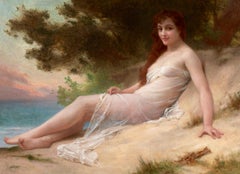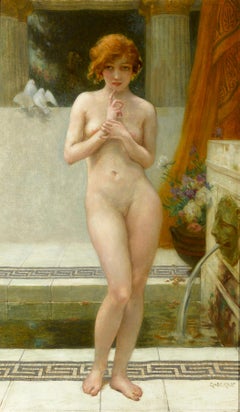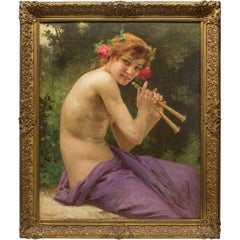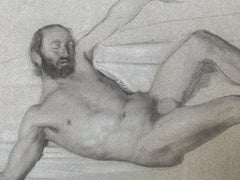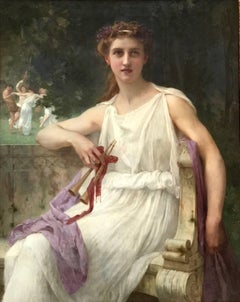Guillaume Seignac Art
to
4
4
2
2
1
1
2
Overall Height
to
Overall Width
to
4
4
3
2
1
1
1
4
5
6,886
3,210
2,514
1,217
4
4
4
4
Artist: Guillaume Seignac
Solitude
By Guillaume Seignac
Located in New Orleans, LA
Signed “G-Seignac” (lower right)
Oil on canvas
French Academic painter Guillaume Seignac was renowned for his masterful treatment of the idealized nude. His languishing female subje...
Category
19th Century Academic Guillaume Seignac Art
Materials
Oil, Canvas
Solitude
By Guillaume Seignac
Located in New Orleans, LA
French Academic painter Guillaume Seignac was renowned for his masterful treatment of the idealized nude. His languishing female subjects based on Greco-Roman prototypes were and rem...
Category
19th Century Academic Guillaume Seignac Art
Materials
Oil, Canvas
Mutine
By Guillaume Seignac
Located in New Orleans, LA
Guillaume Seignac
1870-1924 | French
Mutine
Signed “G. Seignac” (lower right)
Oil on canvas
A mischievous maiden dominates this garden scene by French Academic artist Guillaume ...
Category
Late 19th Century Academic Guillaume Seignac Art
Materials
Canvas, Oil
Fuanesse
By Guillaume Seignac
Located in New York, NY
GUILLAUME SEIGNAC
French, 1870-1924
Fuanesse
Signed 'G. Seignac'
Oil on canvas
32 x 26 inches
Category
Late 19th Century Guillaume Seignac Art
Materials
Oil, Canvas
Related Items
Nude Women with Resting Minotaur - Neutral White Oil Canvas
By Jesus Nodarse
Located in Brooklyn, NY
Oil Painting of a women with a sleeping Minotaur.
Light neutral white painting by Cuban Artist Jesus Nordarse.
Oil on Canvas - 18 x 18 inches.
Oil Painting of a Love and Sacrafice...
Category
2010s Academic Guillaume Seignac Art
Materials
Canvas, Oil
Free Shipping
H 18 in W 18 in D 2 in
Nudo maschile nella posa di un satiro dormiente. XIX secolo
Located in Firenze, IT
Disegno del nudo maschile.
Dal 19 ° secolo
Disegno su carta leggermente colorata.
In buone condizioni.
Il disegno rappresenta un uomo sdraiato, che si abbandona al sonno.
In una posa...
Category
19th Century Academic Guillaume Seignac Art
Materials
Paper, Carbon Pencil
Free Shipping
H 13.39 in W 18.51 in D 0.04 in
Le Martyr de Saint Sebastian (Academic Figurative Oil Painting in Gold Frame)
By Mark Beard
Located in Hudson, NY
Academic style figurative oil painting on canvas
48 x 24 inches unframed
58 x 32 x 3 inches in gold leaf wood frame
This vertical, contemporary figurative painting of Le Martyr de Saint Sebastian was made by Mark Beard under his fictitious artistic persona, Hippolyte-Alexandre Michallon. Painted in a modern Academic style, Beard paints this Christian saint with dramatic detail and emotional gravity. The scene is a common artistic depiction of Sebastian who according to traditional belief, was killed during the Roman emperor Diocletian's persecution of the Christians.
Here the artist depicts a nearly nude Saint Sebastian standing stoically while tied to a rustic brown post. A lush green forested terrain decorates the background while a white neo-classical building sits in the distance, which is perhaps the tomb where Saint Sebastian's remains were laid to rest. Saint Sebastian's pale blue-grey, stone-like stone tone is characteristic of Mark Beard's work who often portrays muscular young men similarly to Greek statues.
The vertical Academic style figurative oil painting is complimented with a vintage style gold leaf wood frame. The painting is signed 'H. A. Michallon 1872' in red oil paint in the lower right corner. The gold frame is also signed and inscribed with black oil paint in several places (please see images).
Mark Beard is a contemporary artist who made this work under the pseudonym Hippolyte A. Michallon who painted during the late 1800's so slight wear (see images) is intentionally staged to align with the factitious artist's purposed history.
About the artist:
Mark Beard is perhaps the most literal example of an artist pulled in so many different directions that he chose to “invent” six different personae in which to channel his overflowing energy and need for expression. Each painting style is radically different from the next, so it remains entirely believable that the work could stem from six completely different people of different time periods and different schools of thought. With a background in set design, Beard has always been one who could conjure total magic with anything available. Mark Beard has exhibited with Carrie Haddad Gallery for nearly twenty years and there has never been a dull moment.
Mark Beard, born in 1956 in Salt Lake city, now lives in New York City. His works are in museum collections worldwide, including the Metropolitan Museum of Art, New York City; the Museum of Modern Art, New York City; the Whitney Museum of American Art, New York City; the Boston Museum of Fine Arts; and the Harvard, Yale, and Princeton University Art Museums; among many others. We would not be the least bit surprised to see new ‘personas’ emerge in the coming years.
About: Hippolyte - Alexandre Michallon, 1849 -1930
The long and peripatetic artistic career of Hippolyte-Alexandre Michallon began in a conventional fashion. The only son of prosperous bourgeois parents in Tours, he first studied drawing with his mother, an accomplished amateur painter of insects. His father, an undertaker who appreciated his son's talent and supported his ambition to become a painter, sent him to Paris at age sixteen to enroll in the studio of Francois-Edouard Picot (1786-1868), an eminent history painter and professor at the Ecole des Beaux-Arts, with whom he studied for three years, until Picot's death. Under his aging teacher's guidance and tutelage, Michallon entered the preliminary stages of the Prix de Rome contest at the Ecole three times, winning an Honorable Mention in 1869 for his composition entitled The Solider of the Marathon.
For the next twenty years Michallon regualarly exhibited paintings on historical and biblical themes at the Paris Salon, as well as commissioned portraits. By his own account, the most ambitious work of Michallon's career was a thirty-foot canvas depicting Noah's Ark, which he exhibited in the Salon in 1875. Michallon began painting atmospheric but zoologically correct images of exotic animals in the wild. These achieved a certain popularity among French and foreign collectors alike, providing Michallon with financial security for the first time in his career.
Michallon moved to England in 1893. His outstanding technical skills easily earned him a position on the faculty of the Slade School of Art in 1900. The craze for animal paintings proved short-lived. He continued to teach at Slade for the next two decades, but his classes gradually dwindled in size as the academic approach and methods he espoused went from outmoded to downright unpopular. Finally in 1922, finding himself reduced to a single pupil, the talented young American Bruce Sargeant, he retired from Slade, persuading Sargeant to leave with him and undergo private instruction at home.
Several years later he retired to a cottage at St. Ives, Cornwall, where he lived quietly until his death in 1930, forgotten by all but a few former students, among them Edith Thayer Cromwell...
Category
Early 2000s Academic Guillaume Seignac Art
Materials
Canvas, Oil
Preparatory anatomical study for the figure of a man with hands on his face.
Located in Firenze, IT
Preparatory anatomical study for the figure of a man with hands on his face.
Drawing of a medium-sized male nude.
From the 19th century
Drawing on slightly greyish colored paper.
In ...
Category
Late 19th Century Academic Guillaume Seignac Art
Materials
Gesso, Paper, Charcoal, Carbon Pencil
Free Shipping
H 17.72 in W 13.39 in
Male and female portrait, both in silk kimono, possibly textile dealers
By Christoffel Lubieniecki
Located in Amsterdam, NL
CHRISTOFFEL LUBIENIECKI (1659-1729)
Pair of portraits of a gentleman and a lady, both in silk kimono, before a country house (circa 1680)
Indistinctly signed “C.......” on a box under the man’s left hand
Oil on canvas, 79.5 x 67 cm each
Both sitters are portrayed wearing a silk “Japanese” coat. During the second half of the seventeenth the Japanese silk coat, an adapted Japanese kimono, became a real vogue in the Dutch elite. The exclusive Dutch trade contacts with Japan can explain the popularity of the kimono-style silk coats in the Netherlands. Everybody who could afford one, dressed in such a fashionable and comfortable coat and, like the present sitters, some proud owners had themselves portrayed in a “Japanese” coat often together with an oriental carpet to underline their standing and international connections. These portraits are the work of the Polish-born portraitist Christoffel Lubieniecki (also known as Lubienitski, Lubinitski or Lubiniecki)
Lubieniecki was first trained in Hamburg under Julian Stuhr and after 1675 in Amsterdam under Adriaen Backer and Gerard de Lairesse. He specialized in landscapes, generally of an Italianate character, and in portraits. The loving execution of these contented burghers, enjoying the garden vistas of their country house, places him alongside Amsterdam portraitists such as Constantijn Netscher and Michiel van Musscher...
Category
1680s Old Masters Guillaume Seignac Art
Materials
Canvas, Oil
Free Shipping
H 31.34 in W 26.38 in D 1.97 in
Nude woman oil on canvas painting
Located in Barcelona, Barcelona
María Rosa Arsalaguet (1922-2003) - Female nude - Oil on canvas
Oil measures 86x65 cm.
Frameless.
painter. He specialized in religious themes, still lifes and flowers.
He participa...
Category
1960s Post-Modern Guillaume Seignac Art
Materials
Oil, Canvas
Continence of Scipio, Erasmus Quellinus, School Rubens, Baroque Art, Old Master
By Erasmus Quellinus the Younger
Located in Greven, DE
Erasmus Quellinus
The Continence of Scipio
Oil on Canvas
The painting is included in the Catalogue Raisonné of the artist.
The Roman commande...
Category
17th Century Baroque Guillaume Seignac Art
Materials
Oil, Canvas
Free Shipping
H 42.52 in W 64.18 in
‘Reclining Young Women’ Figurative, Nude Female Model O/C by Shana Wilson
By Shana Wilson
Located in Carmel, CA
Shana’s portraits adorned two covers of Time Magazine.
Shana’s work is about the face and eyes. Young face, old face, black or white. Her subjects are confused, lonely, ragged and ...
Category
21st Century and Contemporary Expressionist Guillaume Seignac Art
Materials
Oil, Canvas
H 36 in W 48 in D 0.75 in
1900s French Atelier Academic Drawing Portrait of Classical Male Nude Sculpture
Located in Cirencester, Gloucestershire
Life study drawing
original atelier drawing
by the French artist, Jeanne Nachat (1898-1984)
Nachat attended the prestigious Académie des Beaux-Arts in Pa...
Category
Early 20th Century Academic Guillaume Seignac Art
Materials
Pencil, Charcoal
Saint Martin de Porres
Located in New York, NY
Provenance: Private Collection, New York, until 2022.
Martín de Porres was born in Lima in 1579, the illegitimate son of a Spanish-American father, J...
Category
Late 18th Century Guillaume Seignac Art
Materials
Canvas, Oil
Venice Landscape Italian Oil on Canvas Painting in Gilt Wood Frame, Belle Epoque
Located in Firenze, IT
This delightful turn of the century (early 20th century) oil on canvas painting represents an Italian landscape with one of the most famous squares in the world: Piazza San Marco in ...
Category
Early 20th Century Impressionist Guillaume Seignac Art
Materials
Canvas, Oil
Venice Landscape Italian Oil on Canvas Painting in Gilt Wood Frame, Belle Epoque, Early 20th Century
H 51.19 in W 33.47 in D 1.19 in
Portrait of a Lady with a Chiqueador
Located in New York, NY
Provenance: Torres Family Collection, Asunción, Paraguay, ca. 1967-2017
While the genre of portraiture flourished in the New World, very few examples of early Spanish colonial portraits have survived to the present day. This remarkable painting is a rare example of female portraiture, depicting a member of the highest echelons of society in Cuzco during the last quarter of the 17th century. Its most distinctive feature is the false beauty mark (called a chiqueador) that the sitter wears on her left temple. Chiqueadores served both a cosmetic and medicinal function. In addition to beautifying their wearers, these silk or velvet pouches often contained medicinal herbs thought to cure headaches.
This painting depicts an unidentified lady from the Creole elite in Cuzco. Her formal posture and black costume are both typical of the established conventions of period portraiture and in line with the severe fashion of the Spanish court under the reign of Charles II, which remained current until the 18th century. She is shown in three-quarter profile, her long braids tied with soft pink bows and decorated with quatrefoil flowers, likely made of silver. Her facial features are idealized and rendered with great subtly, particularly in the rosy cheeks.
While this portrait lacks the conventional coat of arms or cartouche that identifies the sitter, her high status is made clear by the wealth of jewels and luxury materials present in the painting. She is placed in an interior, set off against the red velvet curtain tied in the middle with a knot on her right, and the table covered with gold-trimmed red velvet cloth at the left. The sitter wears a four-tier pearl necklace with a knot in the center with matching three-tiered pearl bracelets and a cross-shaped earing with three increasingly large pearls. She also has several gold and silver rings on both hands—one holds a pair of silver gloves with red lining and the other is posed on a golden metal box, possibly a jewelry box. The materials of her costume are also of the highest quality, particularly the white lace trim of her wide neckline and circular cuffs.
The historical moment in which this painting was produced was particularly rich in commissions of this kind. Following his arrival in Cuzco from Spain in the early 1670’s, bishop Manuel de Mollinedo y Angulo actively promoted the emergence of a distinctive regional school of painting in the city. Additionally, with the increase of wealth and economic prosperity in the New World, portraits quickly became a way for the growing elite class to celebrate their place in society and to preserve their memory. Portraits like this one would have been prominently displayed in a family’s home, perhaps in a dynastic portrait gallery.
We are grateful to Professor Luis Eduardo Wuffarden for his assistance cataloguing this painting on the basis of high-resolution images. He has written that “the sober palette of the canvas, the quality of the pigments, the degree of aging, and the craquelure pattern on the painting layer confirm it to be an authentic and representative work of the Cuzco school of painting...
Category
17th Century Old Masters Guillaume Seignac Art
Materials
Canvas, Oil
H 66.25 in W 43.75 in
Previously Available Items
Guillaume Seignac Oil on Canvas "Good Friends" Beauty with Kitten Painting
By Guillaume Seignac
Located in New York, NY
Guillaume Seignac (French, 1870-1924). Oil on Canvas "Good Friends" / "Bon Amis" Beauty sitting with her white kitten. Signed G. SEIGNAC Oil on canv...
Category
19th Century Guillaume Seignac Art
Materials
Paint
Euterpe (The Muse of Music) - Beautiful Girl with flute in Classical Landscape
By Guillaume Seignac
Located in Rancho Santa Fe, CA
Guillaume was born in Rennes in 1870, and died in Paris in 1924. He started training at the Académie Julian in Paris, where he spent 1889 through 1895. He had many teachers there, in...
Category
Late 19th Century Academic Guillaume Seignac Art
Materials
Canvas, Oil
Guillaume Seignac art for sale on 1stDibs.
Find a wide variety of authentic Guillaume Seignac art available for sale on 1stDibs. You can also browse by medium to find art by Guillaume Seignac in canvas, fabric, oil paint and more. Not every interior allows for large Guillaume Seignac art, so small editions measuring 26 inches across are available. Customers who are interested in this artist might also find the work of Charles Zacharie Landelle, Charles Joshua Chaplin, and Emile Godchaux. Guillaume Seignac art prices can differ depending upon medium, time period and other attributes. On 1stDibs, the price for these items starts at $36,000 and tops out at $124,500, while the average work can sell for $111,500.

